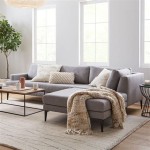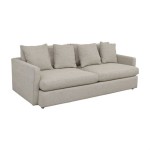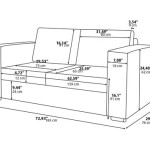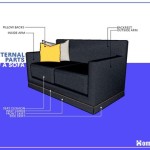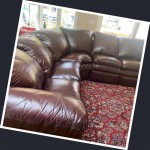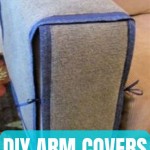Choosing the Best Cat-Friendly Sofa Material
Selecting a sofa often involves balancing aesthetic appeal with practicality, especially for households with feline companions. Cats, with their natural scratching instincts and potential for shedding, can quickly compromise the integrity and appearance of furniture. Choosing a sofa material that can withstand the rigors of cat ownership is crucial for maintaining a presentable and durable living space. This article will explore various options for cat-friendly sofa materials, highlighting their strengths and weaknesses with respect to durability, cleanability, and comfort.
The ideal cat-friendly sofa material should possess several key characteristics. Firstly, it needs to be resistant to scratching and snagging. Cats scratch to sharpen their claws, remove dead nail sheaths, and mark territory. Therefore, a tightly woven or textured fabric that doesn't easily unravel is essential. Secondly, the material should be relatively easy to clean. Accidents, hairballs, and tracked-in dirt are inevitable occurrences in a cat-owning household. A fabric that is stain-resistant and easy to wipe down is highly desirable. Thirdly, the material should be comfortable for both humans and cats. A soft, inviting surface will encourage cats to relax on the sofa rather than seeking out alternative, potentially less desirable scratching targets.
Microfiber: A Durable and Cat-Resistant Option
Microfiber, also known as microsuede or faux suede, is a synthetic fabric composed of tightly woven polyester fibers. This tight weave is a significant advantage in cat-proofing a sofa. The dense construction makes it difficult for cats to sink their claws into the fabric, reducing the likelihood of scratching and snagging. The short, plush pile also minimizes the visual impact of any minor scratches that might occur. Microfiber is known to mimic the touch of genuine suede, but costs less and is more hard-wearing.
Beyond its scratch resistance, microfiber is also relatively stain-resistant and easy to clean. Most spills can be blotted up with a clean cloth, and more stubborn stains can often be removed with a mild soap solution. The synthetic nature of the fabric also makes it less susceptible to water damage compared to natural fibers. Microfiber furniture is available in a broad spectrum of colors and styles, allowing consumers to find a sofa that complements their existing décor. However, it's important to consider that microfiber can sometimes retain pet hair, requiring regular vacuuming to maintain a clean appearance. Some higher-quality microfiber fabrics also benefit from stain-resistant treatments, further enhancing their practicality in a cat-friendly home.
One potential drawback of microfiber is its tendency to generate static electricity, especially in dry environments. This can attract pet hair and dust, requiring more frequent cleaning. Additionally, while generally resistant to scratching, very aggressive scratching behavior might eventually cause some wear and tear over time. Despite these minor drawbacks, the combination of durability, cleanability, and relative affordability makes microfiber a popular and effective choice for cat owners.
Leather: Luxurious and Surprisingly Cat-Friendly
Leather, particularly genuine leather, might seem like an unlikely choice for a cat-friendly sofa. Contrary to popular belief, high-quality leather can be surprisingly durable and resistant to cat damage. The smooth, tight grain of leather makes it difficult for cats to get a good grip, thus discouraging scratching. Furthermore, leather is naturally resistant to absorbing liquids and odors, making it easier to clean up spills and accidents.
The key to leather's suitability lies in the type and quality of the leather. Top-grain leather, which is the highest quality and most durable type, is generally the best choice. It is less susceptible to scratching and tearing compared to lower-quality leather options. It is also important to consider the finish. A protected or finished leather, which has a coating applied to the surface, provides an extra layer of protection against scratches and stains. Aniline leather, which is dyed without a surface coating, is more susceptible to damage and is therefore not recommended for households with cats.
While leather is relatively easy to clean, it does require regular conditioning to prevent it from drying out and cracking. Leather conditioners help to maintain the leather's suppleness and prevent it from becoming brittle, which can make it more vulnerable to scratching. It's also important to clean up spills promptly to prevent staining. However, even with proper care, leather can still be scratched by cats. Any potential scratches will often blend and create a desired, vintage look. Leather ages over time and the patina adds more character giving its unique, distinguished look.
Leather sofas are generally more expensive than microfiber sofas. However, the long-term durability and timeless appeal of leather can make it a worthwhile investment. Leather sofas are also comfortable and stylish, adding a touch of luxury to any living space. Ultimately, the choice between leather and other cat-friendly materials depends on individual preferences, budget, and lifestyle.
Tightly Woven Synthetics: Performance Fabrics with Enhanced Durability
A variety of tightly woven synthetic fabrics, often marketed as "performance fabrics," offer excellent durability and resistance to cat-related damage. These fabrics are typically made from materials such as olefin, acrylic, or polyester, and are designed to withstand heavy use and resist stains, fading, and mildew. The tight weave of these fabrics makes it difficult for cats to snag their claws, minimizing the risk of scratching and tearing.
Performance fabrics often come with added features, such as stain-resistant coatings and antimicrobial treatments. Stain-resistant coatings help to repel liquids and prevent stains from setting in, making it easier to clean up spills. Antimicrobial treatments help to inhibit the growth of bacteria and mold, which can be particularly beneficial in households with pets. These fabrics are a great option for furniture.
One popular type of performance fabric is olefin, which is known for its exceptional durability and resistance to stains, fading, and moisture. Olefin is also relatively inexpensive, making it a budget-friendly option for cat owners. Another popular choice is acrylic, which is known for its softness and resistance to fading. Acrylic fabrics are often used in outdoor furniture due to their ability to withstand the elements, but they are also suitable for indoor use in households with cats.
While performance fabrics are generally durable and easy to clean, it's important to choose a fabric with a tight weave and a relatively smooth surface to minimize the risk of snagging. Fabrics with loose weaves or textured surfaces can be more vulnerable to scratching. It's also advisable to test the fabric's scratch resistance before committing to a purchase. This can be done by gently scratching the fabric with a fingernail or a blunt object to see if it leaves any marks.
Choosing the right under layer, foam density, and frame structure is as important as the material itself. A strong sofa material will be as effective as its support structure. Hardwood frames are preferable over softwood that often breaks easily and can be unstable in the long run. Make sure the under layer material is not easily torn with the aid of claws.
In addition to choosing a cat-friendly sofa material, there are several other steps that can be taken to protect furniture from cat damage. Providing cats with alternative scratching posts and toys can help to redirect their scratching behavior away from the sofa. Regularly trimming cats' nails can also reduce the severity of any scratches that do occur. Applying deterrent sprays or double sided tape to the sofa can also discourage cats from scratching. By taking these preventative measures, pet owners can minimize the risk of furniture damage and maintain a harmonious living environment for both themselves and their feline companions. Another important aspect to keep in mind is that not all cats react the same way to different materials. Some materials may be more enticing to certain felines than others. The owner should try out different options before taking a final decisions to safeguard their sofa integrity. Consider a material that suits your cat's unique personality and scratching habits.

Cat Friendly Sofa Fabric Is It Bulletproof My Decorating Tips

12 Best Couches For Cat Owners Scratch Proof Yet Chic

Cat Friendly Sofa Fabric Is It Bulletproof My Decorating Tips

Solution Cat Friendly Sofa

How To Choose A Pet Friendly Sofa Rose And Grey

Cat Friendly Sofa Fabric Is It Bulletproof My Decorating Tips

Burrow Couch Review 2024 Why I Love My Cat Proof Sofa From

Pet Cat Friendly Design Tips Emily Henderson

7 Pet Friendly Fabrics You Ll Love

The 12 Best Pet Friendly Sofas In 2024 Home Of Cozy

